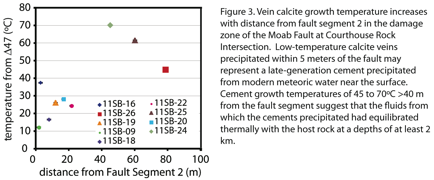www.acsprf.org
Reports: DNI249704-DNI2: The Use of Carbonate 'Clumped Isotope' Thermometry to Quantify Temperatures of Burial and Diagenesis from 0-200C
Katharine W. Huntington, PhD , University of Washington
Quantifying
the temperature conditions under which diagenesis and fluid flow modulate
hydrocarbon maturation, porosity, and permeability is important for predicting
hydrocarbon formation and preservation in tectonically active basins. Clumped
isotope thermometry determines the growth temperature of carbonate minerals
based on the abundance of 13C-18O bonds in the carbonate
crystal lattice, potentially enabling the thermal conditions of fracturing,
fluid flow, and growth of diagenetic minerals in hydrocarbon reservoirs to be
determined independent of the composition of coexisting fluids, pressure, or
time. A single 13C-18O clumping measurement provides
independent estimates of the growth temperature,
![]()
![]()
![]()
We
sampled calcite vein cements near the Moab Fault, a major Laramide normal fault
system in the Paradox Basin and an important natural laboratory for structural
diagenesis studies (e.g., Eichhubl et al., 2009; Chan et al., 2000; Garden,
2001; Davatzes et al., 2005). Previously published vitrinite reflectance,
Rock-Eval Pyrolysis, fluid inclusion, and stable isotope data indicate that the
diagenetic calcites formed during fault-parallel hydrocarbon migration from
deeply circulating meteoric waters (Eichhubl et al., 2009; Chan et al., 2000;
Garden, 2001; Davatzes et al., 2005). Our preliminary clumped isotope analyses,
which focused on large homogenized samples of calcite cements collected in the Moab
Fault deformation zone, are consistent with this general picture and reveal cement
growth temperatures of 43-97°C and a narrow range of calculated
![]()
Using CL microscopy we isolated distinct generations of fault cement, and in several cases analyzed "temporal transects" microsampled across a single calcite crystal. Three calcite crystals from different veins were sampled with increasing distance from the vein wall, and clumped isotope thermometry of these subsamples indicates that calcite growth temperature varied less than 4°C across each crystal. The samples discussed below are limited to a single generation of the most texturally simple cements.
Vein calcite samples
were collected along transects perpendicular to the strike of major fault
segments (Figure 1) to investigate the history of fluid migration along the
fault. The d13C values of the samples have a mostly inorganic signature but are slightly depleted
with respect to formation limestones, suggesting some of the carbon came from
hydrocarbons at depth (e.g., from the Pennsylvanian Ismay and Desert Creek
sections). The
![]()
![]()
![]()
![]()
It is thought that meteoric waters were driven into the basin along the topographic gradient created by uplift of the La Sal Mountains southeast of the Moab Fault. Therefore we expected to find that calcite cements near the fault precipitated from warm fluids derived from depth, and that fluid temperatures equilibrated with the host rock with increasing distance from the fault. However, new temperature data from clumped isotope thermometry reveal the opposite trend (Figure 3). Low-temperature calcite sampled within 5 meters of the fault may represent late cements precipitated from meteoric water near the surface. The temperature of calcite precipitation increases with distance from the fault, to a high temperature of ~70¼C, which is within 10¼C of the maximum burial temperature of the host rock.
We suggest two possible explanations for these observations. (1) Fluids migrated along the Moab Fault and precipitated calcite during ascension and CO2 degassing when the Moab Fault was active in the mid-Tertiary. To precipitate calcite <30°C, cool fluids must have migrated extremely quickly through the basin and along the fault to prevent thermal equilibration with hot country rock. Slow migration of the fluid away from the fault would have allowed thermal equilibration leading to hotter cements farther from the fault. However, it is more likely that (2) deformation and calcite precipitation were long lived. Hot fluids migrated along the Fault and precipitated calcite during fluid ascension and CO2 degassing in the mid-Tertiary. Precipitates far from the fault thermally equilibrated with the host rock (70-80¼C; Chan et al. 2000, Nuccio and Condon, 1997). Later stage calcite precipitated after the fault had been exhumed, thus explaining the cooler temperatures near the fault. This model implies late-stage, shallow fault activity.
Our ongoing work involves direct comparisons of fluid inclusion homogenization temperatures and clumped isotope results in the same sample (collaboration with Peter Eichhubl, UT Austin). We are also improving the precision of clumped isotope thermometry by analyzing synthetic calcite grown at known temperatures between 50-200°C. We completed calcite precipitations at <100°C at UW and at 100, 150, 175, 200, 225°C at UT Austin with Jim Gardner.
In summary, encouraging results from the Paradox Basin and Colorado Plateau (Huntington et al., 2011) demonstrate the utility of clumped isotopes for determining fluid migration temperatures and isotopic compositions in the crust during deformation and thermal perturbation. Upon completion, this work will serve as a model for combining clumped isotope thermometry with isotopes, other temperature proxies, petrography, and structural geology of basins to constrain the thermal and chemical history of fluids in tectonically active reservoirs.



